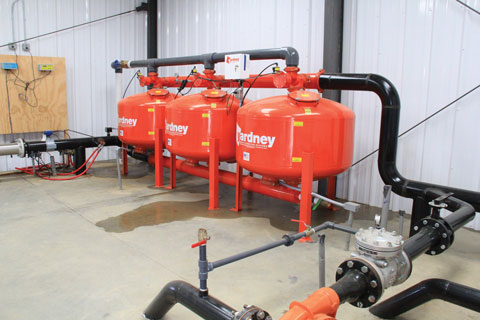11/1/2018
The Inventiveness of Nursery Growers
Jennifer Zurko

Water-quality control
Recently, Bennett’s Creek Nursery in Smithfield has focused more on the quality of their water, said CEO Matt Sawyer. And in order to address the need for more control over their irrigation system, they installed a high-tech pumphouse, complete with sand filtration, acid injection for pH, chlorine injection for sanitizing and fertilizer injection. With the new system, Matt said that they can more easily manipulate the pH in their water, and filter and pump water around specific parts of the nursery. They’ve moved the more “needy plants” to the sections that are serviced by the new water filtration system, which makes sense.
Bennett’s Creek also recycles all of its water, putting it through a sanitizing process and adding beneficial bacteria to keep the algae levels low.
“Water is recycled from the whole property into irrigation ponds that we aerate and add beneficial bacteria to reduce nutrients,” explained Matt. “The water pumped back out of those ponds is sanitized with chlorine gas on the way to the sprinklers.”
Shade cloth stretch
Bennett’s Creek finishes most of their shrubs and perennials in standard hoophouses. Overhead spraying of fungicides or pesticides was proving difficult because each house was covered in shade cloth, which blocked the spray from getting through to the plants below, so the staff was spending a lot of time hand spraying. Matt said that they came up with the idea to pull the shade cloth over TWO hoophouses instead of one, so that it allows them to drive their air blast sprayer between the two houses, treating both houses at once.
Rack ’em and wrap ’em
Twenty-three percent of Lancaster Farms’ offering is shrubs and shipping them to their customers has always been a challenge—especially keeping the plants from falling off the racks. Lancaster has always used these types of racks (with shelves that are open on all four sides) to ship shrubs because they’re easier to load and move around. But they’re using them even more this year due to the new hours of service trucking regulations, said owner Art Parkerson.
“We need to turn our trucks faster, both in loading and unloading,” he said.
However, with the increased frequencyof using this type of rack, it also meant the staff was dealing with trying to secure more plants. Because of the size of the product, the racks are tall, so shrink-wrapping by hand was literally a backbreaking chore.
Daniel Lauver, Lancaster Farms’ Loading Manager, told co-worker Wade Bratton about their problem and Wade came up with an ingenious way to wrap the racks quickly and without any backaches. Taking a regular pallet jack, and modifying it to hold three shrink or mesh wrap spools, Daniel and his team can wrap the racks with a push of a button. Once you tie the wrap to the three shelves of the rack, you push a button and the arm moves around the rack two or three times. You cut the wrap, tie three knots and the rack is ready to push onto the truck.
There are other pallet-wrapping machines that you can get “off the shelf,” said Art, but they wanted to build their own custom one because they wanted it to work “their way.”
“The advantages to ours is it does not require a forklift to place the rack and it uses three (or four) rolls at the same time,” explained Art. “The commercial ones we saw used either one huge roll the height of the whole pallet or needed a lot of rotations to go up and down the pallet. So we think ours is faster and uses a lot less material. GT